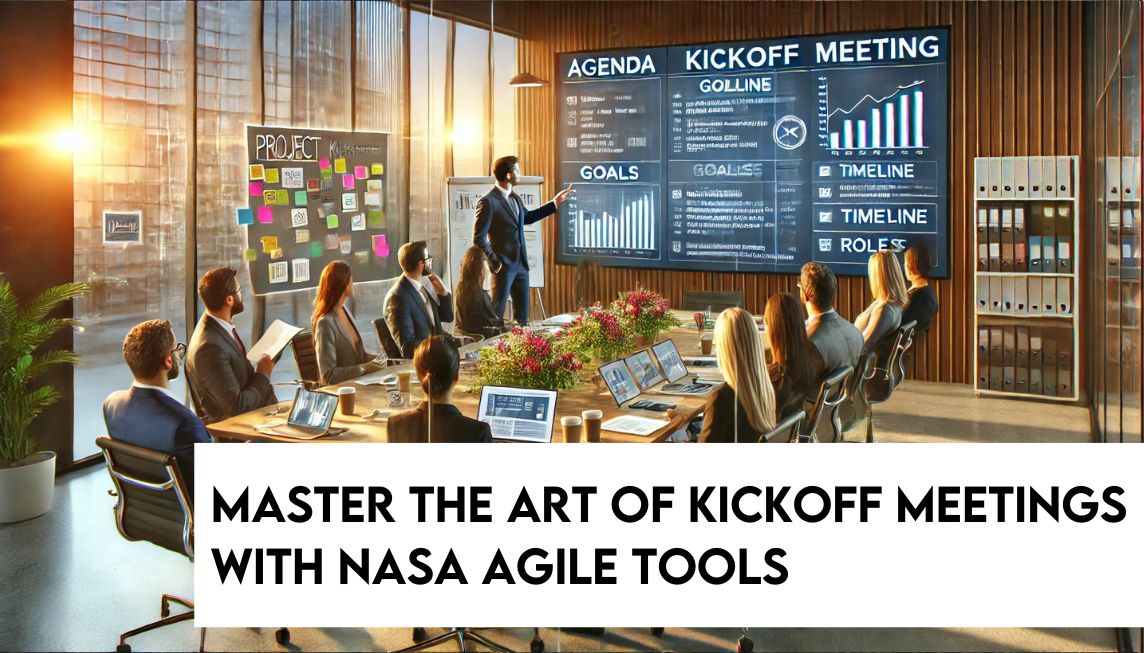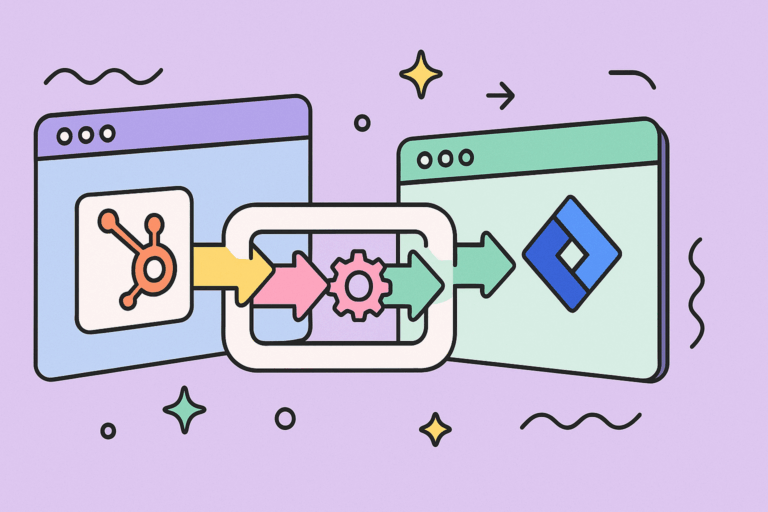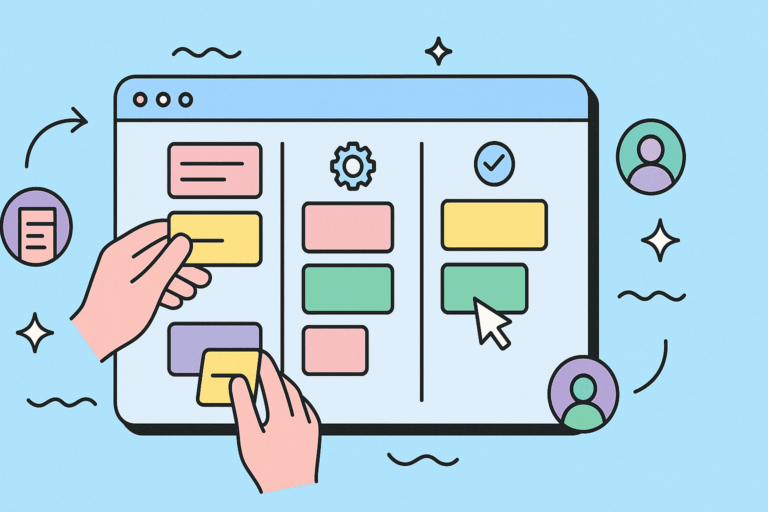Project kickoff meetings are pivotal in setting the stage for a successful initiative, bringing teams and stakeholders together to align on goals, timelines, and responsibilities. This foundational practice ensures clarity and collaboration, which are essential for achieving project kickoff success. In this article, we’ll explore why project kickoff meetings matter, who should attend, and how to conduct them effectively.
Key Takeaways
Project kickoff meetings are essential for establishing clear objectives, building alignment among stakeholders, and identifying potential risks from the outset.
Key participants include the project manager, stakeholders, and project team members, whose collaboration ensures clarity and fosters trust.
Effective kickoff meetings require detailed preparation, structured facilitation, and SMART action items to translate discussions into actionable steps.
Understanding Project Kickoff Meetings
A project kickoff meeting marks the official start of a project, serving as the first formal gathering of the team and stakeholders. These meetings introduce the project’s objectives, timeline, and key deliverables, fostering alignment and a shared understanding of expectations.
Kickoff meetings provide a platform for participants to discuss roles, workflows, and potential risks. They transform abstract plans into actionable steps, establishing a roadmap for project kickoff execution.
The primary purpose of these meetings is to ensure everyone is on the same page before work begins. They are also an opportunity to build trust and collaboration among project team members, creating a unified approach to achieving the project’s goals.
Importance of Project Kickoff Meetings
Project kickoff meeting agendas are crucial for building alignment and accountability. These meetings set the tone for collaboration, transparency, and efficiency. When done right, they establish clear priorities, identify risks, and create a roadmap that minimizes misunderstandings.
For instance, teams that engage in detailed kickoff meetings often avoid pitfalls like misaligned goals, unclear responsibilities, and missed deadlines. By fostering early buy-in from stakeholders, kickoff meetings contribute to smoother workflows and higher project success rates.
Key Objectives of a Project Kickoff Meeting Agenda
Kickoff meetings aim to clarify three main areas: the project’s goals, scope, and execution plan. During these discussions, teams define what success looks like, allocate resources, and outline individual roles and responsibilities.
Another critical objective is to identify potential risks and dependencies early. This allows teams to establish mitigation strategies before challenges arise, ensuring smoother execution.
Lastly, fostering collaboration and open communication ensures that all participants feel aligned and invested in the project’s success.
Who Should Attend a Project Kickoff Meeting?
The effectiveness of a kickoff meeting depends heavily on the right mix of participants. The core attendees typically include:
Project Manager: Leads the meeting and ensures alignment.
Team Leads: Represent various departments and contribute expertise.
Key Stakeholders: Provide strategic direction and outline expectations.
Vendors (if applicable): Address any external dependencies or deliverables.
Avoid overloading the meeting agenda with unnecessary participants, as this can dilute focus and reduce productivity.
Roles and Responsibilities
Project Manager: Facilitates the discussion, ensuring alignment and documenting decisions.
Team Leads: Provide technical insights, identify resource needs, and raise any initial concerns.
Stakeholders: Offer strategic guidance and ensure the project aligns with broader organizational objectives.
Each participant plays a vital role in contributing their unique perspective, ensuring the project plan is robust and comprehensive.
How to Conduct an Effective Project Kickoff Meeting
Preparation: Begin by creating a detailed agenda and sharing it with participants ahead of time. Include key topics such as objectives, timelines, and risks.
Facilitation: During the meeting, guide discussions to ensure focus and encourage participation. Use visuals like workflows or timelines to enhance clarity.
Action Items: Conclude the meeting by assigning tasks and deadlines, ensuring everyone knows their responsibilities. Document these items to facilitate follow-through.
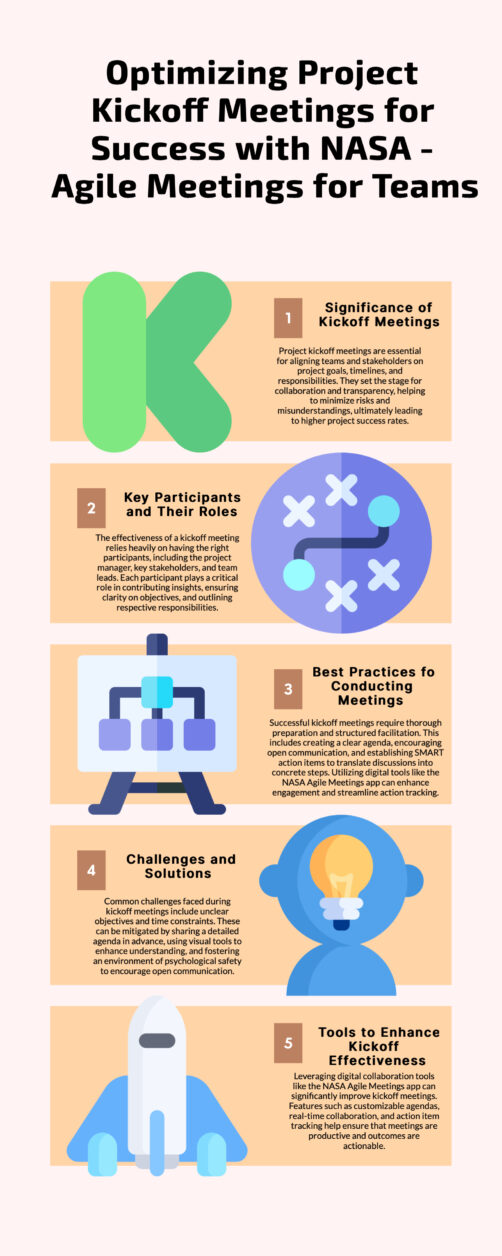
Preparation Steps
Preparation is key to a successful kickoff meeting. Start by defining the meeting’s objectives and creating a time-boxed agenda. Share this agenda with participants in advance to help them prepare.
Gather relevant data, such as timelines, resource availability, and potential risks. Using tools like Gantt charts or visual workflows can make complex plans easier to understand.
Enhance engagement by including icebreakers or prompts that encourage participants to share their expectations and concerns.
Facilitating the Meeting
Effective facilitation ensures the meeting stays productive and focused. The project manager should start by outlining the meeting’s purpose and setting a collaborative tone.
Encourage open communication by asking specific questions and ensuring all voices are heard. Address concerns constructively and keep discussions on track using frameworks like the “5 Ws” (Who, What, When, Where, Why).
End the meeting with a summary of key decisions and action items, ensuring clarity and accountability.
Creating Action Items
SMART action items (Specific, Measurable, Achievable, Relevant, Time-bound) are essential for translating meeting discussions into actionable steps. Assign each action item to a specific owner and set clear deadlines.
Document these items and track progress regularly. Tools like the NASA Agile Meetings for Teams app can help teams manage action items efficiently, ensuring they are implemented and reviewed in subsequent meetings.
Common Challenges and Solutions in Kickoff Meetings
Kickoff meetings can face obstacles like unclear objectives, misaligned expectations, and time constraints. To address these:
Share a detailed agenda beforehand to ensure alignment.
Use tools to visualize timelines and workflows, fostering understanding.
Allocate time for Q&A to clarify doubts and ensure consensus.
Managing Time Effectively
Time management is critical for keeping the meeting productive. Stick to a pre-shared agenda and allocate specific times for each topic. Avoid overloading the meeting with unnecessary details—focus on high-priority issues.
Taking short breaks in longer meetings can also help maintain engagement and focus.
Encouraging Open Communication
Psychological safety is key to fostering open communication. Begin the meeting by emphasizing that all feedback is valued. Use techniques like round-robin sharing to ensure quieter participants have a chance to contribute.
Ensuring Follow-Through on Action Items
Follow-through is vital for ensuring the outcomes of the kickoff meeting translate into project success. Regular check-ins and progress reviews help teams stay on track and address any obstacles proactively.
Tools and Techniques for Project Kickoff Meetings
Digital tools are indispensable for effective kickoff meetings. The NASA Agile Meetings for Teams app is a standout solution, offering features like:
Customizable Agendas: Structure discussions with pre-built templates.
Real-Time Collaboration: Foster active engagement during meetings.
Action Tracking: Assign, monitor, and follow up on action items seamlessly.
Tool Integration: Connect with platforms like Jira and Asana for streamlined workflows.
Digital Collaboration Tools
In today’s hybrid and remote work environments, digital collaboration tools are essential for conducting effective project kickoff meetings. These tools enable teams to stay aligned, communicate clearly, and manage action items efficiently, regardless of physical location.
The NASA Agile Meetings for Teams App stands out as a leading platform for facilitating kickoff meetings. Here’s how it enhances the process:
Customizable Meeting Templates: Easily tailor meeting agendas to suit your project’s unique needs, ensuring that no critical topic is overlooked.
Real-Time Collaboration: Engage all participants actively, whether they’re in the room or dialing in remotely. With interactive features, team members can contribute their insights seamlessly.
Asynchronous Input: Recognizing the challenges of different time zones, the app allows participants to add comments or updates before the meeting, making the kickoff more productive.
Action Item Tracking: Ensure follow-through by documenting responsibilities, deadlines, and next steps directly within the app. This built-in accountability fosters a culture of execution.
Integration Capabilities: The app integrates with widely used project management tools like Jira, Asana, and Trello, bridging the gap between planning and execution.
User-Friendly Interface: Its intuitive design minimizes the learning curve, allowing teams to focus on collaboration rather than navigating complex software.
For distributed teams, the NASA app addresses common challenges such as engagement and communication barriers, ensuring every voice is heard. By leveraging a robust digital tool like this, teams can transform their project kickoff meetings into a launchpad for success.
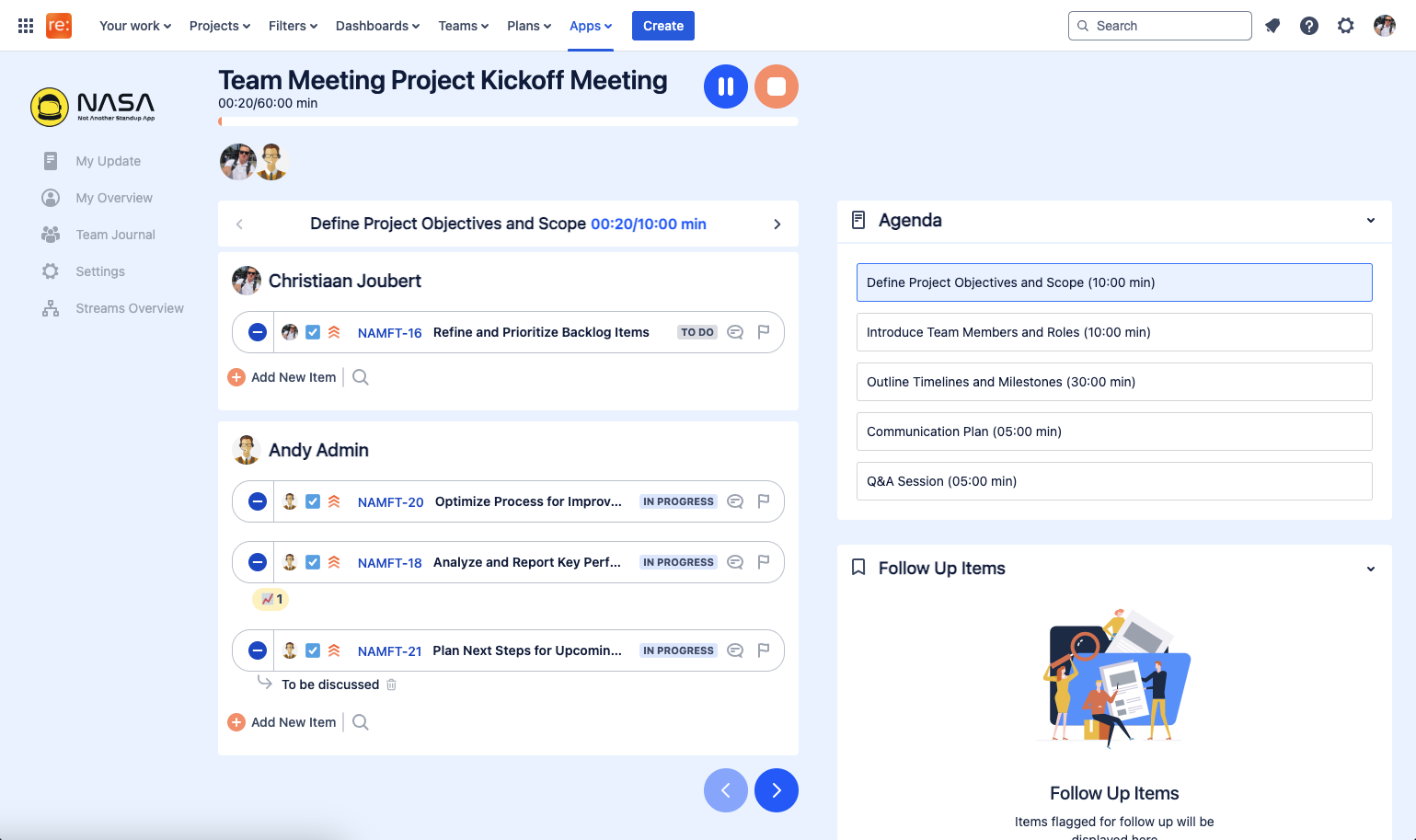
Popular Kickoff Techniques
Techniques like brainstorming workshops and dot voting can make kickoff meetings more interactive and productive. Using visual tools like mind maps or roadmaps further enhances engagement and understanding.
Summary
Project kickoff meetings are the foundation of successful project execution. By fostering alignment, identifying risks, and building collaboration, these meetings set the stage for seamless workflows and successful outcomes.
Using tools like the NASA Agile Meetings for Teams app ensures your kickoff meetings are structured, engaging, and action-oriented. With careful preparation, effective facilitation, and follow-through on action items, teams can turn plans into results.
Master Your Project Kickoff Meetings Today
Project Kickoff meetings are more than just an introduction—they’re the catalyst for alignment, clarity, and momentum. With NASA Agile Meetings for Teams, you can revolutionize your kickoff process, ensuring every stakeholder and team member is set up for success.
Transform Your Kickoff with These Features:
Seamless stakeholder alignment tools for clear communication.
Structured frameworks to define objectives, timelines, and roles.
Risk and dependency management from day one.
Take Action Now:
See NASA in Action: Schedule a demo to explore how our platform enhances kickoff meetings and drives project success.
Learn More: Visit our Product Page for tips on aligning teams, managing risks, and fostering collaboration.
Download Now: Get NASA Agile Meetings for Teams on the Atlassian Marketplace and redefine your kickoff strategy today.
Ready to make your project kickoff meetings the foundation of your success? Take the next step with NASA Agile Meetings for Teams.
Frequently Asked Questions
Why are kickoff meetings important?
They ensure alignment, clarity, and collaboration among stakeholders, minimizing risks and setting a strong foundation.
Who should attend a kickoff meeting?
The project manager, team leads, key stakeholders, and external vendors (if applicable).
How can I ensure effective facilitation?
Use a structured agenda, encourage open communication, and conclude with SMART action items.
What tools can enhance kickoff meetings?
The NASA Agile Meetings for Teams app offers features like real-time collaboration, action tracking, and tool integrations.
How do I ensure follow-through on action items?
Assign responsibilities, set deadlines, and regularly review progress to maintain accountability.
Mastering the Art of a Successful Kickoff Meeting: A Complete Guide
What is a Project Kickoff Meeting?
Definition and Purpose
A project kickoff meeting is a critical part of the project initiation phase, where you finalize details, motivate your team, and move a project forward.
It’s an opportunity to establish your leadership style and bring the team together with a clear vision for project success.
The primary purpose of a project kickoff meeting is to get everyone on the same page and off to a great start.
Preparing for a Successful Kickoff Meeting
Pre-Meeting Preparation
Define the project scope and objectives.
Identify the project team and stakeholders.
Prepare a clear agenda and outline.
Hold an internal kickoff meeting before meeting with the client to establish the project’s scope and vision.
Get the team’s input and give them the information they need to succeed.
Running an Effective Kickoff Meeting
During the Meeting
Make introductions and review the project’s purpose and general objectives.
Discuss what you expect the team to deliver and how you will measure success.
Review everyone’s roles and responsibilities, provide details about the project’s timeline, and discuss communication logistics.
Leave time for a Q&A session at the end.
Keep the meeting focused and on track, avoiding unnecessary tangents or distractions.
Project Scope and Objectives
Project Scope Overview
Explain the statement of work and project deliverables.
Discuss the project scope and key features and functionalities.
Reassess if the goals are realistic and achievable within the project constraints.
Clarify what’s in scope and what’s out of scope.
Project Objectives
Share the business drivers for initiating the project from the client’s perspective.
Initiate a discussion on how the project will make a difference in people’s lives and how it will meet their needs.
Answer the questions “Why are we working on this?” and “What are we working towards?”
Project Planning and Management
Project Manager Role
The project manager defines roles and responsibilities for the project team.
Clear job descriptions and responsibilities ensure a smooth project execution.
The project manager creates the project communication plan and presents it during the kickoff meeting.
Project Budget and Timeline
Outline the project’s budget, goals, timeline, and strategies.
Discussing potential issues or challenges can increase the likelihood of a successful project.
Provide a chronological roadmap for the project, including milestones, tasks, and deadlines.
Risk Management and Change Control
Risk Management Overview
Risk management involves analyzing potential risks, determining responses, and prioritizing risks based on impact.
A risk mitigation strategy outlines who is responsible for each risk.
Identify potential risks and develop a plan to mitigate them.
Change Management Overview
Change management provides a structure for dealing with internal or external changes throughout the project.
Effective change management ensures a smooth project execution.
Establish a clear process for handling changes and updates.
Project Communication Plan
Communication Objectives
Outline how the project team will communicate important information to stakeholders.
Define the communication channels and protocols.
Ensure that all stakeholders are informed and aligned throughout the project.
Communication Channels
Establish a central source of truth for project information.
Use project management software to facilitate communication and collaboration.
Define the frequency and format of project updates and reports.
Project Management Methods and Tools
Project Management Methodologies
Project management methods include waterfall, agile, or hybrid approaches.
Choose the right project management methodology for your project.
Consider the project’s complexity, scope, and timeline when selecting a methodology.
Project Management Tools
Use project management software to streamline project planning and execution.
Choose tools that integrate with your existing workflows and systems.
Consider the scalability and flexibility of the tools.
Project Success Criteria
Defining Success
Define what success looks like for the project.
Establish clear and measurable objectives.
Align the project’s objectives with the organization’s goals.
Measuring Success
Develop a plan to measure and track project success.
Establish key performance indicators (KPIs) and metrics.
Regularly review and assess project progress.
Post-Meeting To-Dos
Meeting Minutes and Action Items
Send out meeting minutes or a summary.
Share action items and responsibilities.
Ensure that all stakeholders are aligned and aware of their responsibilities.
Next Steps and Follow-Up
Outline the next steps and timeline.
Establish a clear plan for follow-up and check-ins.
Ensure that all stakeholders are informed and aligned throughout the project.
Challenges of a Kickoff Meeting
Common Challenges
Lack of clear objectives and scope.
Insufficient communication and collaboration.
Unrealistic expectations and timelines.
Inadequate risk management and change control.
Best Practices for a Successful Kickoff Meeting
Preparation is Key
Prepare a clear agenda and outline.
Define the project scope and objectives.
Identify the project team and stakeholders.
Hold an internal kickoff meeting before meeting with the client.
Conclusion
Recap and Summary
A successful project kickoff meeting sets the tone for the entire project.
It’s essential to prepare, communicate, and collaborate effectively.
Establish clear objectives, scope, and timelines.
Use project management software to streamline project planning and execution.
